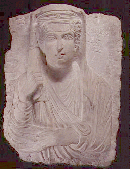Images.

Funerary Bust from Palmyra (Syria) 2-3rd century B.C.
Courtesy of the Semitic Museum, Harvard University. Photo by Carl Andrews. SM# 1902.45.29.
Listing sponsored by
KappaElastin™
Scientific
Breakthrough. No Shots
Science response to skin aging.
www.kappaelastin.com
Phone: 617 495 4631 -
TTY:
Ancient and Medieval NearEastern and Egyptian archaeology.
http://www.fas.harvard.edu/~semitic/hsm/AboutMuseum.htm
The Semitic Museum of Harvard University is a university museum, founded in 1889 by David Gordon Lyon and Jacob H. Schiff. It houses both Harvard's collections of Near Eastern artifacts and its Department of Near Eastern Languages and Civilizations.
http://www.fas.harvard.edu/~semitic/hsm/AltSemMuseumHome.htm
The Houses of Ancient Israel: Domestic,
Royal, Divine.
The exhibit features a cut-away model
of an early Israelite house showing everyday life in the 8th c. B.C.E. as the
Domestic component. The Royal and Divine sections relate to the Iron Age
II, the time of the divided monarchy of Israel and
Judah.
Nuzi and the Hurrians: Fragments from a
Forgotten Past.
The exhibit details the daily life of the Hurrians from
around 1,400 B.C.E. living in the small town of Nuzi (northeastern Iraq).
Approximately 100 objects from the Museum's collection of over 10,000 Nuzi
artifacts are displayed, including cuneiform tablets, seals, glass, and
pottery.
Ancient Cyprus: The Cesnola Collection.
Featured are
pottery vessels, glass, lamps, figurines and bronzes from Cyprus, dating from c.
2000 B.C.E. to 300 C.E. Luigi Palma di Cesnola excavated in Cyprus
in the mid-1800's and later became the first director of the Metropolitan Museum
of New York.
Hours:
10-4 M-F; 1-4 Su. Closed
Saturdays and University holidays. For information, news01@artcom.com Office
(617-495-4631).
Admission:
Free. Groups should make
advance reservations with the Museum Office (617-495-4631). The Museum is not
handicapped accessible.
Directions:

Funerary Bust from Palmyra (Syria) 2-3rd century B.C.
Courtesy of the Semitic Museum, Harvard University. Photo by Carl Andrews. SM# 1902.45.29.
Do you have any additional comments concerning this site?